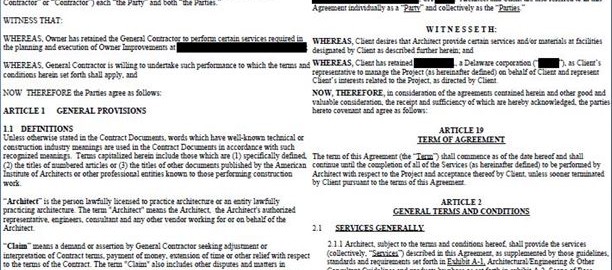What Are You Really Going to do About Change Orders?
For most tenants or owners the answer is: surprisingly little. Buy why? The answer lies in an inconspicuous, often overlooked spot in the real property design & construction supply chain: the contract.
The reason is deceptively simple. Once a contract for architectural or general construction services is signed, the scope and body of the agreement either avoids change orders, controls them, or ignores them and optimistically assumes the best. The latter position relinquishes control and creates the environment that puts change orders in motion. And this puts the tenant at a disadvantage.
Too little attention is paid to the power of the procurement process. Consider what Barry Lapatner, in Broken Buildings, Busted Budgets, says:
“[B]uilding contractors [and architects] have at their fingertips all the critical information to establish the business terms with their buyers [owners], but the buyers do not [emphasis added]. That is, the contractor possesses far superior technical and operational knowledge of the industry then all owners,…”
So what does this mean? Specifically, what can you really do to prevent change orders? Consider these five tactics.
Change your mindset. Start by considering what hasn’t worked in the past; or has at least been ineffective. This means to de-emphasize project backend beat downs intended to curtail change orders by brute force. Hammering the general contractor for the costs, or even the existence, of change orders is unfair. A general contractor, however clever, doesn’t have the exclusive ability to create change orders.
Let go of liquidated damages. This seems to be the old school, go-to solution for many tenants and owners. My view? It’s just mutually assured litigation and unnecessary, ineffective mountains of paperwork. LDs suggest a damaged relationship with key professionals right from the start. It’s the design and construction equivalent of a prenuptial agreement. If you need one, maybe it’s not such a great match. Instead, the root cause is further up the real property improvement supply chain. And that’s where we need to set our sights.
Prevention versus prediction. I remember a colleague of mine commenting this way about the attitude he was seeking in his team members, “I want news makers, not news reporters.” Similarly, reports like risk registers that indicate the likelihood of change orders or the potential impact only deliver the news. The iceberg is already dead ahead. Instead, the solution is to navigate further back in the project improvement supply chain timeline.
Procurement process and not project delivery. Design-bid-build, construction management at risk, and integrated project delivery are all often referred to as a project delivery methodologies. This isn’t an entirely accurate description. They are procurement approaches. They are contractual purchasing mechanisms. Because they are procurement processes at the core, they necessarily happen at the very earliest spot in the real property improvement supply chain. This is the origins and the opportunity for improvement for most change orders.
The power of the procurement process. Change orders are ensured or avoided the minute the ink dries on the architectural/engineering or construction contract. Or put another way, if the contract, specifications and scope of the contract with your professionals doesn’t exclude and or control change orders, what will?
The solution isn’t your garden-variety legal terms and conditions. I’m not talking about fill-in-the-blank template. And I’m certainly not referring to the vendor’s form of contract. If you’re not emphasizing the power of the procurement process and utilizing a refined services agreement, brace yourself or bolster your budget.
Remember the words of Barry LaPatner.
“The contractors’ [and architects’] superior knowledge and informational advantage coupled with the knowledge that [design] errors equal change orders.”
A sophisticated agreement is the most powerful and overlooked advantage in the toolkit of the right project manager – to head off change orders, reduce risks, and control the effects of substandard design and construction.
So before wading into this complex arena, give yourself an advantage and a project management ally up front. Do this simple step and you’ll be able to maximize the value of the vendors you hire, minimize change orders, and enjoy peace of mind along with substantial cost savings.
Apex Project Consulting, Inc., (www.apexpjm.com) based in Southern California, provides one-of-a-kind, full-spectrum project management leadership across a wide variety of project types, including both ground-up and tenant improvements, throughout the U.S. as well as internationally. Apex has managed over eleven hundred projects, from due diligence and design through construction, including commercial, industrial, office, clean rooms, life science, labs, manufacturing, and specialized environments.
Mr. Conzelman is a licensed electrical contractor and general contractor, LEED® AP, CCM, and a California RE Broker License 01128636. Mr. Conzelman graduated from Western State University, College of Law and has taught Contracts-for-Contractors. Tom Conzelman is the author of “Protect Your Project”, the innovator behind the No Change Order Guarantee™ and the creator of the revolutionary Negatively Inferred Scope™ procurement process; Stopping Specification-Driven Change Orders and Rework.



